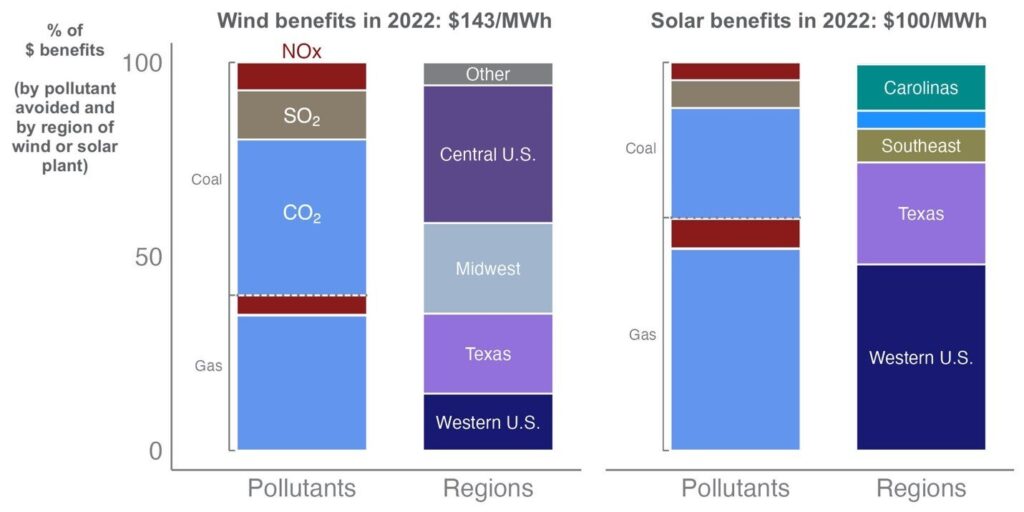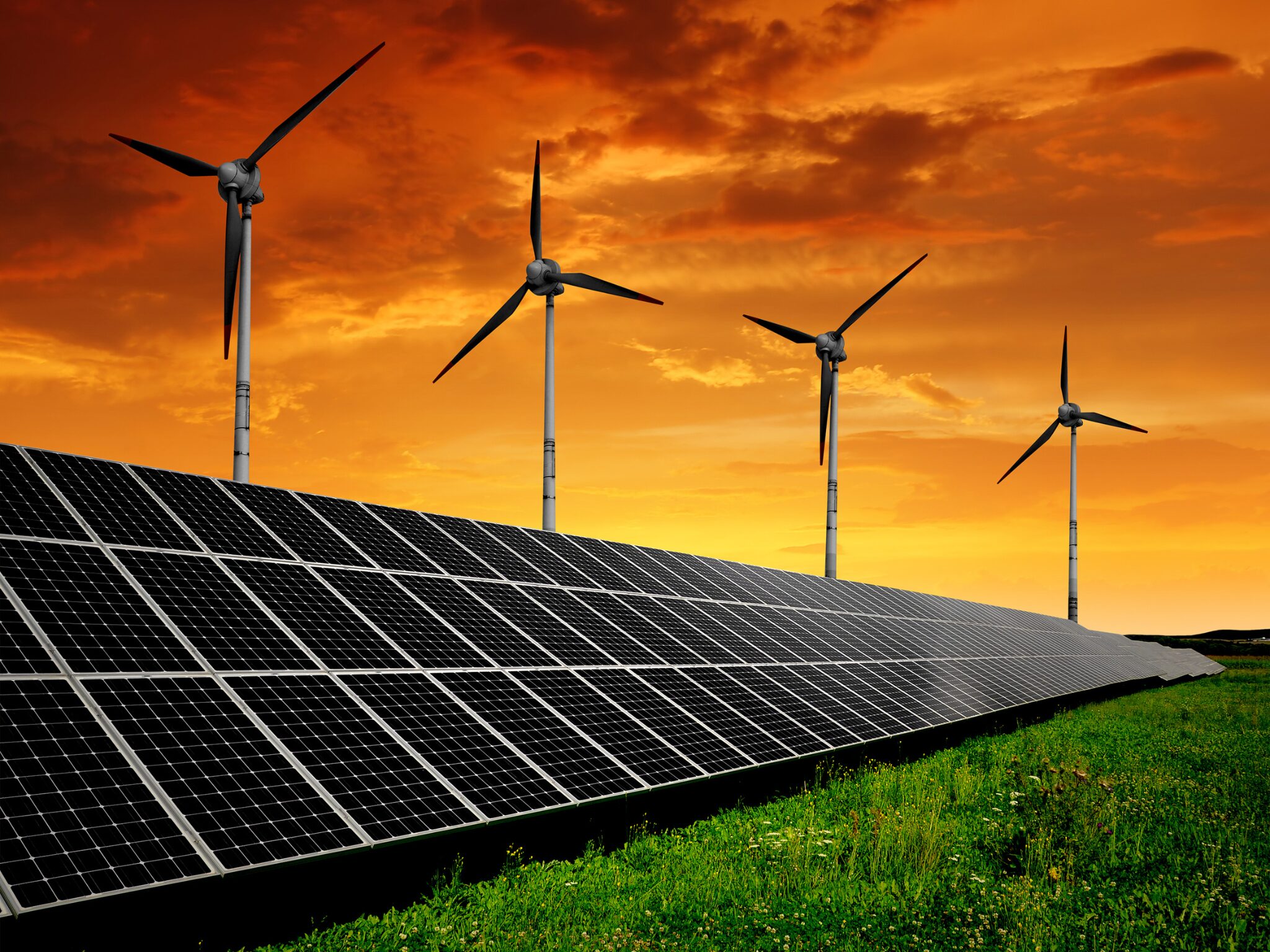In 4 Years, Renewable Energy Has Yielded $250B in Health & Climate Benefits in the US
5 Mins Read
The increasing use of wind and solar energy in the US is driving massive economic benefits and emission reductions in the US, according to a new study.
Lower emissions, better air quality, and greater health benefits – these are the headline gains from the rise of renewable power in the US. Between 2010 and 2020, the country’s wind and solar generation capacity quadrupled from 40 gigawatts to 166 gigawatts – and for the first five months of last year, these sources generated more electricity than coal, following a trend from 2022.
This has driven significant climate benefits, according to a new study by the Lawrence Berkeley National Laboratory (LBNL) and green energy consulting firm Clean Kilowatts. Published in the Cell Reports Sustainability journal, the research focuses on wind and solar energy from 2019 and 2022, and the accompanying impact on carbon dioxide, sulfur dioxide (SO2), and nitrogen oxides (NOx).
“From 2019 through 2022, wind and solar generation increased by about 55%,” LBNL scientist Dev Millstein told the Guardian. “By 2022, wind and solar provided roughly 14% of total electricity needs for the US.”
The study estimates that by reducing the need for fossil fuel electricity generation, the US avoided 915 million tonnes of CO2 emissions, which is equivalent to taking over 217 million gas-powered vehicles off the road for a year. Additionally, wind and solar energy use also removed 525,000 of SO2 and 468,000 tonnes of NOx from the atmosphere – both of which are produced during fossil fuel combustion and linked to greater asthma risk and a host of other conditions.
Wind and solar energy are saving lives

The researchers calculated economic benefits based on three factors: the change in gas or coal generation, the emissions rate of the generator type, and the damage caused by emissions changes. Over the four-year period, the hike in renewable energy brought about $249B in climate and health benefits to the US.
In 2022 alone, wind and solar energy provided $62B and $12B, respectively, in combined climate and air quality benefits. This is equivalent to $143 per MWh of wind energy, and $100 per MWh of solar power. When accounting solely for air quality, wind and solar energy provided $16B and $2.2B worth of health gains.
The latter figures are derived almost entirely from a reduced risk of premature deaths across the US. In 2022, the increased solar and wind capacity led to 1,200 to 1,600 fewer deaths, thanks to the removal of over 250 million tonnes of CO2 (a number that steadily increased over the period covered in the study).
To contextualise this, the authors point to research suggesting that improvements in the prevention and treatment of heart disease and cancer can reduce 21,000 premature deaths per year in the US until 2030. While wind and solar benefits are comparatively small, but “not negligible”. It also tackles a highly concerning trend – each year, the premature deaths of 350,000 Americans are attributed to fossil fuel pollution.
“These findings can help us target future wind and solar development to provide the greatest climate and health benefits,” said Johnson.
US investment in renewable energy at all-time high

There is a major disparity between the benefits of wind and solar energy – the former is responsible for much greater emission cuts and economic potential. But this gap makes sense when you consider that wind power has penetrated the US energy mix much more than solar installations. In 2023, wind energy generated 430 billion kWh of electricity in the country, versus 163 billion kWh from solar power.
The report also outlines how many areas that rely more heavily on wind are also more dependent on coal. So greater wind power use leads to a higher level of coal pollution being avoided.
Differences in the location of renewable energy plants also highlight the contrast in impact. For example, solar power primarily benefitted Western US, Texas, the Southeast, and the Carolinas, while wind energy aided Texas, Central US, and the Midwest. The latter two have a relatively higher amount of coal generation, and vice versa for the Western US region. This is consistent with the fact that most wind emission benefits come from offsetting coal power, and solar benefits are derived from offsetting gas generation.
Johnson said he hoped the research would help showcase the already-tangible advantages of solar and wind energy. “It is also important to recognise when something is working,” he said, particularly since people are “often focused on the challenges we face” with the climate crisis.
The US has been bolstering its clean energy investments in recent years, with financing from private and government sources reaching a record $239B in 2023, a 38% rise from the year before. These have been supported by legislations like the Inflation Reduction Act and the Bipartisan Infrastructure Law, which provide R&D grants and tax incentives for clean energy. The latter made up the vast majority of federal renewable power investment last year (which reached $34B).
The focus on renewable energy is in line with a recent report that suggests governments stop issuing new oil, gas and coal licences, since there are enough fossil fuel projects planned to meet global energy demand forecasts for 2050. A transition away from fossil fuels was the major talking point of the UN’s flagship climate conference in Dubai last year, though the final text avoided the mention of a ‘phaseout’. But COP28 did call on governments to speed up the transition to renewable energy in their next round of climate commitments (or nationally determined contributions) due next year.



